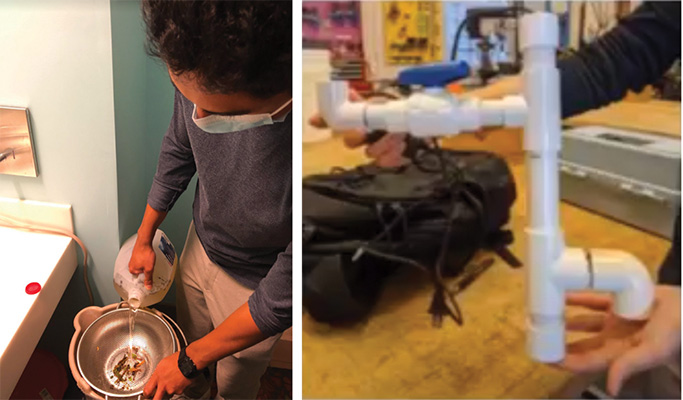
Overview
In Nepal and India, there are many families and establishments that do not have access to clean water, and this problem is compounded by a lack of accessible water quality testing options. Water sources are commonly contaminated with E. coli, a bacterium that can cause diarrheal disease when ingested. Such diseases are a leading cause of death in young children. Children in schools must bring boiled water from home to ensure that their drinking water is clean, which can affect education access.
D-Lab has an ongoing project (led by D-Lab lecturer Susan Murcott) to spread cheap, simple, and high-quality ECC vial water tests in this region. The team successfully launched the ECC vial as a product of the ENPHO organization in Nepal, but the shelf-life of the ECC vial is currently unknown. A more recent extension to this work, the UV-JAL project, is focused on developing a prototype for a small, self-contained, and easily connectorized device that sanitizes water via UV-C irradiation before it flows out of the faucet. Once the prototype is developed and fully tested, we aim to bring the technology to schools in Nepal. Our current efforts to improve the prototype are focused on switching to an LED UV-C source and to solar power.

Shelf life study
If guidelines for a shelf life study can be put together, and if the shelf life is longer than anticipated, it will make the ECC vial more cost-efficient and will lower the barrier for people to purchase and use the test kit.
Currently, the shelf-life of the ECC vial water quality tests is unknown. However, one of the chemical components has a state shelf-life of only 6 months, which would limit usefulness to the intended market. Researchers Pramina Nakarmi and Isha Dhakal from the NFA started a shelf-life study about 1.5 years ago. However, the results of that study are unknown to us due to lost communication during the pandemic. While we are not able to conduct a long-term shelf life study, we propose to establish contact with the NFA researchers and compile data from their work and online resources. We will develop guidelines for a new study to test and increase the shelf life of the ECC Vial. These guidelines could then be used by a future team to implement the shelf-life study.
Market analysis
Ultimately, the goal of the project is to provide a cheap, effective and portable solution. In order to ensure that viable alternatives are not overlooked and our solution is still best in class, a market analysis was conducted. If other solutions are better, promoting those alternatives might be a better approach to solving the issue at hand.
Given the massive efficiency improvements when it comes to COVID-19 testing capabilities, we looked into potential lessons learned that would be applicable to E.Coli testing.
Solar adaptation
If the water purification prototype can be run on solar energy, schools that have the device would have the option to run the device on either electricity or solar energy. If they choose to run it on solar energy, they can save electricity when running the water purification device, which will both entice schools to adapt the technology based on cost savings, and will not negatively impact the environment. Depending on the location of the school, unreliable or non-existing electricity access might make solar panels the only option for powering the product.
Our current prototype for UVC sanitation of communal water supplies relies on wall electric power, which is then converted to the 24V DC needed to run the antimicrobial light. We aim to offer the option of solar energy by establishing an optional connection directly from the solar panel to the light.
LED irradiation source
The current iteration of the UV-Jal prototype (developed by former DLab students Ankita Singh and Deb Go) uses UV-C filament bulbs to power disinfection. However, LEDs are more power-efficient and have a longer average rated life than filament light bulbs. If a functional prototype can be created using UV-C LEDs, then the device will be easier to power via solar panel and more cost-efficient over long periods of time.
It is well known that UV-C light with a wavelength near 254 nm can be used to sanitize water by disrupting the DNA of E. coli and other coliforms. Mercury filament lamps are most commonly used for irradiation, but their power requirements make them ill-suited for use far from an electrical grid. We aim to assemble a prototype that uses readily-available LEDs to achieve performance equivalent to that of a filament source. One of the challenges in this project comes from the low penetration depth of the short-wavelength UV-C light - the UV-C has a very low transmission through most materials that might be used to waterproof the circuit.
MIT D-Lab class
Student team
Students are MIT students unless otherwise noted.
- Rosan Bishwakarma, Harvard '22, Economics
- Alex Greene G, pursuing a PhD in quantum computing with superconducting circuits with the EQUS group
- Audrey Leibig '22, Chemical Engineering with a minor in Environment and Sustainability
- Safiyyah Ogundipe '24, Chemical-Biological Engineering
Community partners
Mentors
- Bidusha Poudyal - mentor
- Susan Murcott - mentor
- Pramina Nakarmi - scientist in Nepal
- Isha Dhakal - scientist in Nepal
Contact
Libby Hsu, MIT D-Lab Associate Director of Academics; Lecturer

